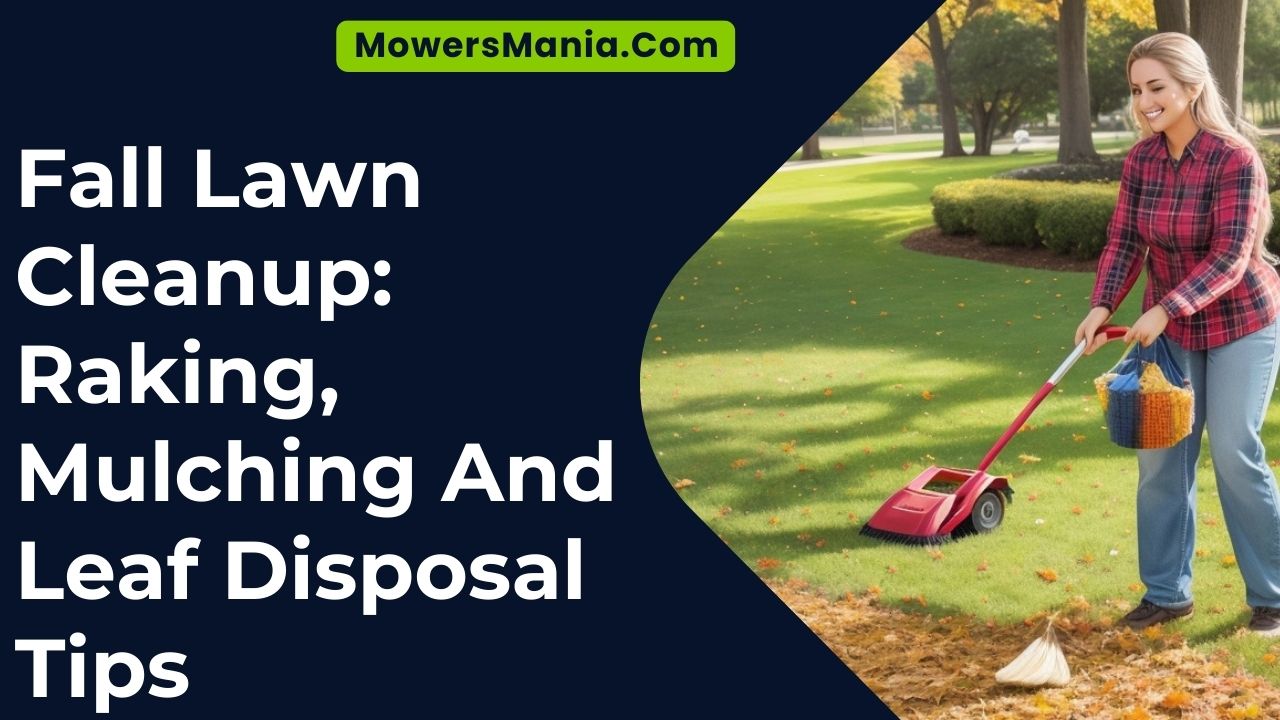Are you ready to tackle your fall lawn cleanup?
In this article, we’ll give you all the tips and tricks you need to make the process a breeze. From choosing the right tools to efficient raking techniques, and the benefits of mulching leaves, we’ve got you covered.
We’ll also discuss safe and eco-friendly leaf disposal methods, including composting for nutrient-rich soil.
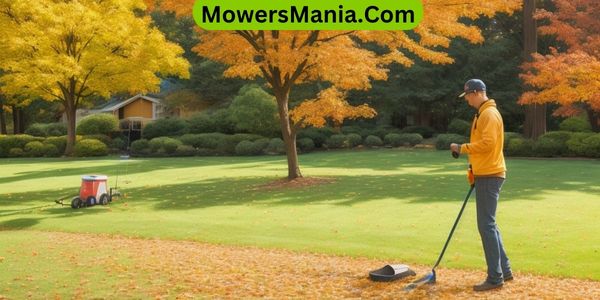
Get ready to transform your yard and prepare it for the winter months ahead.
Choosing the Right Tools
To effectively choose the right tools for fall lawn cleanup, assess your specific needs and consider investing in a sturdy rake and a mulching mower.
Your first priority should be a sturdy rake. Look for one with strong tines that won’t bend or break easily. A rake with adjustable handles can also be helpful, as it allows you to customize the length to your comfort.
A mulching mower is another essential tool to consider. This type of mower not only cuts the grass, but also shreds leaves into smaller pieces, which can then be left on the lawn as a natural fertilizer. It saves you the time and effort of raking and bagging leaves separately.
When choosing a mulching mower, look for one with a powerful engine and sharp blades for efficient mulching.
Additionally, consider the size of your lawn and the amount of leaves you typically deal with. A larger lawn may require a self-propelled mower for easier maneuvering.
Raking Techniques for Efficient Cleanup
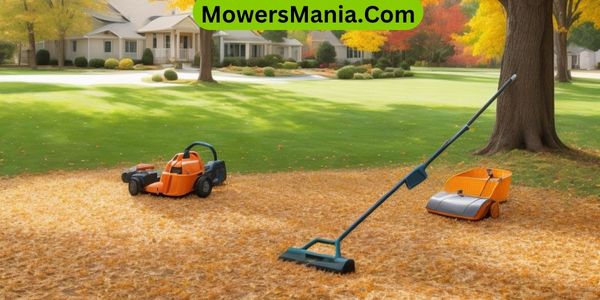
Use a sturdy rake and efficient raking techniques to quickly and effectively clean up your lawn in the fall. By following these tips, you can make the task much easier and more efficient:
Benefits of Mulching Leaves
When it comes to mulching leaves, there are several benefits to consider.
Nutrient-Rich Soil Amendment
Enhance the health of your soil by incorporating mulched leaves, which enrich its nutrient content and promote optimal plant growth.
Mulching leaves not only saves you time and effort by eliminating the need for leaf disposal, but it also offers several benefits to your soil:
- Nutrient-rich soil: As the mulched leaves break down, they release essential nutrients such as nitrogen, phosphorus, and potassium into the soil. These nutrients are vital for healthy plant growth and development.
- Improved soil structure: Mulched leaves help improve the soil’s structure by increasing its organic matter content. This enhances its ability to retain moisture, improves aeration, and promotes better root penetration.
- Weed suppression: A layer of mulched leaves acts as a natural weed barrier, preventing weed seeds from germinating and competing with your plants for nutrients and space.
Weed Suppression Technique
Mulching leaves provides an effective weed suppression technique that can benefit your lawn and garden in multiple ways.
By spreading a layer of shredded leaves over the soil, you create a natural barrier that prevents weed seeds from germinating and growing. This reduces the need for frequent weeding and saves you time and effort.
Additionally, mulching leaves helps retain moisture in the soil, preventing it from evaporating and keeping your plants hydrated. The decomposing leaves also add organic matter to the soil, improving its structure and fertility.
As the leaves break down, they release essential nutrients that nourish your plants, promoting healthy growth.
Moisture Retention Benefits
By mulching leaves, you can significantly improve moisture retention in your lawn and garden. This simple technique offers several benefits that can enhance the health and appearance of your outdoor space:
- Water conservation: Mulching leaves creates a protective layer that prevents evaporation, allowing the soil to retain moisture for longer periods. This reduces the need for frequent watering and helps conserve water resources.
- Improved soil structure: As the mulched leaves decompose, they enrich the soil with organic matter, improving its structure and promoting better water absorption. This leads to healthier root systems and stronger, more resilient plants.
- Weed suppression: The layer of mulched leaves acts as a natural weed barrier, blocking sunlight and preventing weed seeds from germinating. This reduces the competition for water and nutrients, further aiding in moisture retention for your lawn and garden.
How to Properly Mulch Leaves?
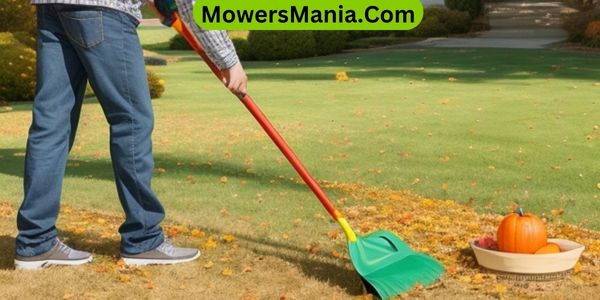
Now, let’s talk about how to properly mulch your leaves.
Mulching leaves offers several benefits for your lawn, including providing nutrients and acting as a natural weed suppressant.
To properly mulch leaves, you’ll need to use the right technique and choose the appropriate type of mulch.
Benefits of Mulching Leaves
To maximize the benefits of mulching leaves, you can easily and effectively incorporate them into your lawn care routine. Instead of raking and disposing of the fallen leaves, consider mulching them with your lawn mower.
Here are three key benefits of mulching leaves:
- Nutrient-rich soil: When leaves are mulched, they break down and release essential nutrients back into the soil. This natural process improves the overall health of your lawn and promotes better growth.
- Weed suppression: Mulching leaves creates a protective layer that helps suppress weed growth. This reduces the need for herbicides and minimizes the competition between weeds and your grass.
- Moisture retention: Mulched leaves act as a natural insulator, helping to retain moisture in the soil. This can be especially beneficial during dry periods, as it reduces the need for additional watering.
Mulching Techniques for Leaves
Wondering how to properly mulch leaves to maximize their benefits for your lawn? Mulching leaves is a great way to recycle them and provide your lawn with essential nutrients.
Follow these simple mulching techniques to ensure an effective leaf mulching process:
| Technique | Description |
|---|---|
| Mow and mulch | Use a mulching mower to chop the leaves into small pieces. This will allow them to break down faster and blend into the grass. Avoid cutting more than one-third of the grass height at a time. |
| Mulch and compost | Spread a layer of shredded leaves over your garden beds or compost pile. This will help retain moisture, suppress weeds, and break down into rich organic matter. |
| Bag and mulch | Collect leaves with a bagging attachment on your mower. Empty the bags into a designated mulch area, creating a layer of shredded leaves. This will provide insulation and protection for your plants during the winter. |
Types of Mulch for Leaves
You can properly mulch leaves by choosing the right type of mulch for your lawn and garden. Mulching leaves not only helps to improve soil health and moisture retention but also reduces weed growth and prevents erosion.
Here are three types of mulch that are ideal for leaves:
- Shredded Leaves: Shredding the leaves before mulching allows for better decomposition and nutrient release. You can use a lawn mower or a leaf shredder to shred the leaves into small pieces.
- Wood Chips: Wood chips are a popular choice for mulching leaves as they provide good insulation and moisture retention. They also break down slowly, enriching the soil over time.
- Pine Needles: Pine needles make an excellent mulch for acid-loving plants. They’re lightweight, long-lasting, and help to suppress weed growth.
Leaf Disposal Methods to Avoid
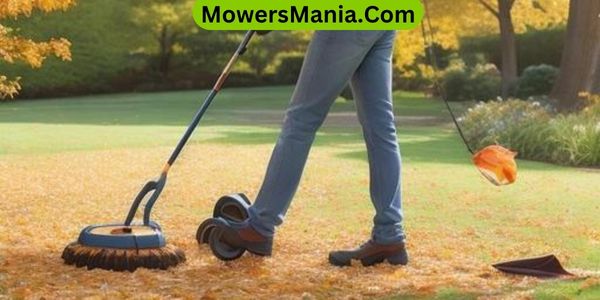
Avoid using plastic bags for leaf disposal as they contribute to environmental pollution and hinder the natural decomposition process. Plastic bags aren’t biodegradable and can take hundreds of years to decompose, leading to long-term environmental damage.
When you dispose of leaves in plastic bags, they end up in landfills where they’re compacted and deprived of oxygen. This prevents the leaves from breaking down naturally and releasing nutrients back into the soil.
Instead of using plastic bags, consider alternative methods for leaf disposal. One option is to mulch the leaves using a lawnmower with a mulching attachment.
This chops the leaves into smaller pieces, allowing them to break down faster and become a natural fertilizer for your lawn. Another option is to create a compost pile or bin specifically for leaves.
By composting leaves, you can transform them into nutrient-rich compost that can be used to improve the soil in your garden.
If you must bag your leaves, opt for biodegradable paper bags instead. These bags are made from natural materials and will break down over time. They’re a more environmentally friendly option and can be used as part of your composting process.
Remember to check with your local waste management facility for any regulations or guidelines regarding leaf disposal in your area.
Composting Leaves for Nutrient-Rich Soil
To create nutrient-rich soil for your garden, start by composting your leaves. Composting leaves is a simple and effective way to recycle organic material and turn it into a valuable resource.
Here are some tips to help you get started:
- Gather fallen leaves: Rake up the leaves from your lawn and collect them in a pile. You can also include other yard waste, such as grass clippings and small branches, to add variety to your compost.
- Shred the leaves: Shredding the leaves into smaller pieces can speed up the composting process. You can use a shredder or simply run over the pile with a lawn mower a few times.
- Create a compost pile: Build a compost bin or designate an area in your yard for the leaves to decompose. Layer the shredded leaves with other compostable materials, like kitchen scraps and garden waste, to create a balanced mixture.
Composting leaves not only helps reduce waste and save landfill space but also produces nutrient-rich compost that can be used to fertilize your garden. By following these simple steps, you can turn your fall leaves into a valuable resource that will benefit your garden for years to come.
Tips for Safe and Eco-Friendly Leaf Disposal
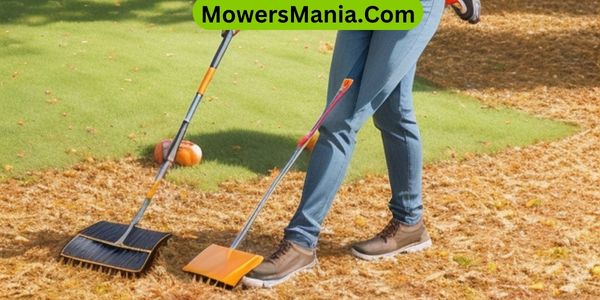
For safe and eco-friendly leaf disposal, it’s important to regularly and responsibly remove fallen leaves from your lawn.
Leaving a thick layer of leaves on your lawn can block sunlight and air from reaching the grass, leading to mold, disease, and dead patches. Plus, fallen leaves can become slippery when wet, creating a potential hazard for you and your family.
So, here are some tips to help you dispose of leaves in a safe and eco-friendly manner.
First, consider using a mulching mower to break down the leaves into smaller pieces. This not only helps with leaf disposal but also provides a natural source of nutrients for your lawn.
Alternatively, you can collect the leaves using a rake or leaf blower and then compost them. Composting leaves not only reduces waste but also creates nutrient-rich soil that can be used in your garden or flower beds.
If you don’t have the option to compost, you can bag the leaves and dispose of them with your yard waste. However, it’s important to check with your local waste management facility for specific guidelines on leaf disposal.
Some municipalities have leaf pick-up programs, while others may require you to drop off the bags at designated locations.
Frequently Asked Questions [FAQs]
How Often Should I Rake My Lawn During the Fall Season?
You should rake your lawn during the fall season as often as necessary to keep it clean and free of leaves. Regular raking helps maintain the health and appearance of your lawn.
Can I Use a Leaf Blower Instead of a Rake for Fall Lawn Cleanup?
Yes, you can use a leaf blower instead of a rake for fall lawn cleanup. It can be a quicker and easier way to remove leaves from your lawn, but be sure to follow proper safety precautions.
Is It Necessary to Remove All the Leaves From My Lawn Before Winter?
Yes, it is necessary to remove all the leaves from your lawn before winter. Leaving them can suffocate the grass and lead to mold or diseases. Rake or use a leaf blower for cleanup.
Can I Mulch Leaves From Different Tree Species Together?
Yes, you can mulch leaves from different tree species together. It’s a great way to recycle organic matter and add nutrients to your soil. Just make sure to shred them into small pieces for best results.
Are There Any Specific Safety Precautions I Should Take When Disposing of Leaves?
When disposing of leaves, remember to wear gloves to protect your hands from potential allergens or irritants. Also, make sure to avoid inhaling dust or debris by wearing a mask.
Conclusion
So remember, when it comes to fall lawn cleanup, using the right tools and techniques can make all the difference.
Raking efficiently and mulching leaves can save you time and effort, while also benefitting your soil.
Just be sure to avoid improper leaf disposal methods and consider composting your leaves for nutrient-rich soil.
By following these tips, you can have a clean and eco-friendly yard this fall.

